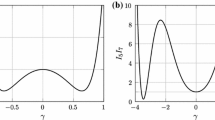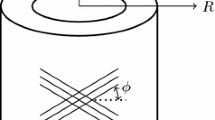Abstract
The principal problem of interest in this paper is that of the area-preserving azimuthal shear strain of an incompressible transversely isotropic hyper-elastic circular cylindrical tube subjected to homogeneous radial tractions on both its inner and outer boundaries. A considerable part of the solution to this problem is achieved numerically. A comparison is made between the stress distributions obtained here when fibres are very strong and their counterparts obtained in the limiting case of an ideal fibre-reinforced material [Soldatos, J Eng Math 68(1):99–127, 2010]. Pure azimuthal shear strain may be considered as a particular case of the present deformation. However, in the present case, equilibrium requires a change of the inner and outer tube boundaries which, due to the incompressibility constraint, may take place only in a manner which preserves the area of the tube cross section. Another particular case is the isotropic material counterpart of the present problem, which was considered previously [Dagher and Soldatos, J Eng Math 78(1):131–142, 2013].







Similar content being viewed by others
References
Rivlin RS (1949) Large elastic deformations of isotropic materials. VI. Further results in the theory of torsion, shear and flexure. Philos Trans R Soc Lond Ser A Math Phys Sci 242(845):173
Kassianidis F, Ogden RW, Merodio J, Pence TJ (2008) Azimuthal shear of a transversely isotropic elastic solid. Math Mech Solids 13(8):690
Dorfmann A, Merodio J, Ogden RW (2010) Non-smooth solutions in the azimuthal shear of an anisotropic nonlinearly elastic material. J Eng Math 68(1):27–36
Soldatos KP (2010) Second-gradient plane deformations of ideal fibre-reinforced materials: implications of hyper-elasticity theory. J Eng Math 68(1):99–127
Soldatos KP (2009) Azimuthal shear deformation of an ideal fibre-reinforced tube according to a second gradient hyper-elasticity theory. In: Proceedings of the 7th EUROMECH solid mechanics conference. Portugal, Lisbon, September, pp 7–11
Spencer AJM (1972) Deformations of fibre-reinforced materials. Oxford University Press, London
Dagher MA, Soldatos KP (2013) Area-preserving azimuthal shear deformation of an incompressible isotropic hyper-elastic tube. J Eng Math 78(1):131–142
Qiu GY, Pence TJ (1997) Loss of ellipticity in plane deformation of a simple directionally reinforced incompressible nonlinearly elastic solid. J Elast 49(1):31–63
Merodio J, Ogden RW (2002) Material instabilities in fiber-reinforced nonlinearly elastic solids under plane deformation. Arch Mech 54(5):525–552
Hart WL (1966) College Algebra, 5th edn. D. C. Heath and Company, Lexington, Massachusetts
Griffiths LW (1947) Introduction to the theory of equations. Wiley, New York
Pipkin AC, Rogers TG (1971) Plane deformations of incompressible fiber-reinforced materials. J Appl Mech 38:634–640
Author information
Authors and Affiliations
Corresponding author
Appendix: Inextensible fibres
Appendix: Inextensible fibres
Using the components of \(\mathbf {a}\) defined in (5.2), the equation of the deformed fibres (the so-called \(a\)-curves) is found to be
The orthogonal trajectories of the \(a\)-curves in the plane of the deformed cross section define the so-called \(n\)-curves [6], having unit tangent
The equation of those curves is therefore
These two families of curves define a local, orthogonal, curvilinear co-ordinate system, which will be found useful when equilibrium is considered.
Due to the plane-strain nature of the problem, the constraints of material incompressibility and fibre inextensibility leave independent only one of the invariants (2.12) [6]. This may be chosen to be \(J_1\), and the strain energy density should be regarded a general function of it, namely
The corresponding constitutive equations can then be deduced directly from [4] by neglecting the fibre bending stiffness terms considered there.
Hence, considering that the implied inextensible fibres are perfectly flexible, one obtains
where \(T\) is the arbitrary tension that represents the reaction of the material to the constraint of fibre inextensibility. Moreover, \(s_{\alpha \beta }\) are the components of the so-called extra stress tensor (with the exception of \(r\), \(\theta \) and \(z\), as well as \(a\) and \(n\) below, Latin indices operate in three dimensions, Greek indices in two dimensions). In addition, consistency with the imposed material constraints requires that the components of the extra stress tensor satisfy the following conditions [4, 6]:
where repeated indices imply summation over the range of their values.
In the aforementioned local curvilinear co-ordinate system, the components of the extra stress tensor are described as follows [4, 6, 12]:
where \(s_a\) and \(s_n\) are the normal components of the extra stress tensor, and hence
represents the local shear stress component. Thus, when the constraint Eqs. (8.6) are combined with (8.5d), (8.7) reduces to
in which \(\tau \) is to be determined using constitutive equations as soon as the form of the strain energy density of the material becomes available.
For consistency with the application detailed in Sect. 4, it is now assumed that the strain energy density is that of the standard neo-Hookean material, namely
where, after (2.12a) and (5.1), \(J_1\) necessarily takes the form
The constitutive Eq. (8.5c) then yields the non-zero components of the extra stress tensor as follows:
and hence (8.8) leads to
Equations (8.5) thus reveal that the only remaining stress unknowns are the functions \(p\) and \(T\), which must be determined by solving the two simultaneous equations of static equilibrium.
Those equilibrium equations obtain a standard form in the local co-ordinate system of the \(a\)- and \(n\)-curves [4, 6, 12], which, in the absence of body forces, is as follows:
Here, \(p\) and \(T\) are replaced by the new pair of unknowns
and therefore the in-plane Cauchy stress components (8.5a) take the following alternative form:
In (8.14), \(l_a\) and \(l_n\) denote the arc length along the \(a\)- and \(n\)-curves respectively, while \(\kappa _a\) and \(\kappa _n\) are the curvatures of those curves defined as follows:
Thus, using (5.2) and (8.2), it is seen that
making it immediately clear that the fibres remain straight and, in accordance with theoretical expectations [6], the \(n\)-curves maintain their curvature after deformation. Moreover, the use of (8.1) and (8.3) provides the necessary relationship between the deformed cylindrical polar co-ordinates and the co-ordinates of the curvilinear local co-ordinate system; this is as follows:
Using these results, the equilibrium equations (8.14) reduce to
Equation (8.20b) can be integrated immediately along the \(n\)-curves to give
where \(f_1(l_a)\) is an arbitrary function of integration. Equation (8.20a) can also be integrated subsequently along the \(a\)-curves to yield
where \(f_2(l_n)\) is a second arbitrary function of integration.
Use of the boundary conditions (2.17a) and (2.18a) in connection with (8.16) yields the pair of algebraic equations [4, 5]
which are used in connection with (8.21b) and (8.22) to determine the arbitrary functions \(f_1(l_a)\) and \(f_2(l_n)\). Application of the first of these boundary conditions \((k=0)\) yields
Since \(l_a\) and \(l_n\) are independent variables, (8.24) can be satisfied only if \(f_1(l_a)\) and \(f_2(l_n)\) are both constant; these constants are denoted in what follows by \(f_1\) and \(f_2\) respectively.
Application of the boundary condition (8.23) at the outer tube boundary \((k=1)\) further yields
where the constant \(M\) is given as follows:
Solving (8.24) and (8.25) simultaneously, we obtain the values of \(f_1\) and \(f_2\) as
Hence, performing the integration presented in (8.22), one finds
With \(t_a\) and \(t_n\) now known, the unknown functions \(p\) and \(T\) can also be determined; using (8.15), we find them to be
Thus, the components of the Cauchy stress tensor can be deduced from the constitutive Eqs. (8.5), which lead to their final explicit form (5.3).
Rights and permissions
About this article
Cite this article
Dagher, M.A., Soldatos, K.P. Area-preserving azimuthal shear deformation of an incompressible tube reinforced by radial fibres. J Eng Math 95, 101–119 (2015). https://doi.org/10.1007/s10665-014-9728-z
Received:
Accepted:
Published:
Issue Date:
DOI: https://doi.org/10.1007/s10665-014-9728-z




